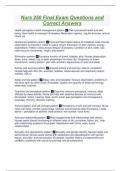Nurs 250 Final Exam Questions and
Correct Answers
Health perception-health management pattern ✅Client perceived health and well-
being; How health is managed (Examples: Medication regimen, regular exercise, annual
check up)
Nutritional-metabolic pattern ✅Food and fluid intake relative to metabolic need; Nurses
observation is important: intake & output record; Education on diet, calories, energy,
expenditure; Pattern varies across lifespan (Examples: Condition of skin, teeth, hair,
nails mucous membranes, height, and weight)
Elimination pattern ✅Excretory function of bowel, bladder, skin; Nurses observation:
feces, urine, sweat; Key to body physiologic functions (Ex: Frequency of bowel
movements, voiding pattern, pain with urination, appearance of urine and stool)
Activity and exercise pattern ✅physical activity and exercise, leisure, recreation;
Nurses help with ADL (Ex: exercise, hobbies, cardiovascular and respiratory status,
mobility, ADL's)
Sleep and rest pattern ✅Sleep, rest, and relaxation; Nurses observation: problems in
this area spill into other areas (Examples: Quality and quantity of sleep and energy,
sleep aids, routines)
Cognitive and perceptual pattern ✅Cognitive, sensory-perceptual, memory; Most
affected by sleep deficits; Nurse can help with assistive devices as memory aids
(Examples: Vision, hearing, taste, touch, smell, pain perception and management,
language, memory, decision making)
Self-perception and self-concept pattern ✅Perceptions of self and self-concept; Nurse
helps with body comfort, body image, feelings and emotional state (Examples: Listed
above + perception of abilities, body posture, eye contact, voice tone)
Role and relationship pattern ✅Role engagements and relationships with others;
Nurses assist clients functioning in different roles of life, as mother, father, etc., help
with relationship problems (Examples: Satisfaction with family, work, social
relationships)
Sexuality and reproductive pattern ✅Sexuality and gender identity; Sexual needs and
performance; Nurses assist clients with satisfaction and dissatisfaction with gender
issues, sexuality, and reproduction (Examples: Number history of pregnancies and
childbirth, problems with sexual functioning, sexual satisfaction)
, Coping and stress tolerance pattern ✅Management of stresses of daily life as well as
extraordinary stresses that come with illness and disability; Nurses assess clients
general coping pattern and effectiveness in stress tolerance (Examples: Handling
stress, support systems, ability to control or manage situations)
Value and belief pattern ✅Clients sense of values, what he/she believes in, religion;
Nurse assesses values, beliefs (including spiritual) or goals that guide choices or
decisions (Examples: Religious affiliation, important things in life, value-belief conflicts
related to health)
Roles of a Nurse Manager ✅Plan - identify and develop
Organize - use resources to meet objectives
Direct - lead others toward goals; finances
Control - continuous evaluation
5 rights of delegation ✅1. Right task
2. Right circumstance
3. Right person
4. Right direction/communication
5. Right supervision/evaluation
(Should NEVER delegate roles such as nursing assessment, plan progress, diagnosis,
patient teaching, etc)
Reflecting ✅repeating what patient said, to ensure active listening
Silence ✅slows down, helps to watch, collects thoughts
Clarifying ✅asking to explain again - not sure of meaning
Therapeutic Communication Techniques ✅Reflecting, silence, broad openings,
focusing, shared perceptions, general leads, acknowledgment/validation, clarifying,
active listening, touch, humor, empathy, warm, develop relationship, show confidence,
summarizing, identifying problem and discussing feelings drive and motivation.
Blocks/barriers to communication ✅Clichés, why questions intimidate, judgement,
opinions, change subject, false reassurance, aggressiveness, stereotyping, testing,
rejecting, giving unwanted advice (agreeing and disagreeing both can shut your patient
down, you want them to elaborate)
Open-ended questions ✅allows patients to express themselves and use their own
words to describe what is going on
Closed-ended questions ✅Yes or no questions; limits patients' expressions, doesn't
allow for the expression of feelings and other concerns, makes the patient address
small things with one or two words, doesn't keep the conversation flowing




